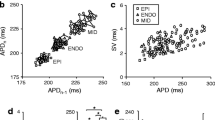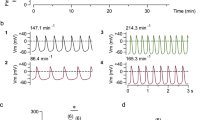Abstract
Modulation of the ventricular action potential by β-adrenergic activation of Ca2+, K+ and cyclic adenosine monophosphate (cAMP)-dependent Cl− channels was assessed in enzymatically isolated guinea-pig ventricular myocytes. The effectiveness and relative selectivity of 9-anthracene carboxylic acid (9-AC), as an antagonist of cAMP-dependent Cl− channels was also tested. Membrane currents and action potentials were recorded using the conventional whole-cell variant of the patch-clamp technique or with the amphotericin B perforated-patch technique. The β-adrenergic agonist isoproterenol either increased or decreased action potential duration depending on whether the dominant effect was on inward Ca2+ currents or on outward K+ or Cl− currents. When Ca2+ and K+ channel modulation was prevented by nisoldipine and low temperature respectively, β-adrenergic activation of Cl− channels caused a significant reduction in action potential duration and a slight depolarization of the membrane potential. The β-adrenergic-mediated effects were reversed by the Cl− channel blocker, 9-AC. In the absence of β-adrenergic stimulation, 9-AC had no detectable effects on action potentials or Ca2+ currents. These results suggest that β-adrenergic activation of Cl− channels is a potent mechanism for regulation of action potential duration and that 9-AC may be a useful, relatively specific, pharmacological tool for evaluating the physiological role of cAMP-activated Cl− channels in heart. 9-AC also reversed the ability of isoproterenol to antagonize prolongation of action potential duration by the class III antiarrhythmic agent E-4031.
Similar content being viewed by others
References
Bahinski A, Nairn AC, Greengard P, Gadsby DC (1989) Chloride conductance regulated by cyclic AMP-dependent protein kinase in cardiac myocytes. Nature 340:718–721
Bean BP, Nowycky MC, Tsien RW (1984) β-Adrenergic modulation of calcium channels in frog ventricular heart cells. Nature 307:371–375
Bretag AH (1987) Muscle chloride channels. Physiol Rev 67:618–724
Brown AM, Birnbaumer L (1988) Direct G protein gating of ion channels. Am J Physiol 254:H401-H410
Bryant SH, Morales-Aguilera A (1971) Chloride conductance in normal and myotonic muscle fibres and the action of monocarboxylic aromatic acids. J Physiol (Lond) 219:367–383
Cabantchik ZI, Greger R (1992) Chemical probes for anion transporters of mammalian cell membranes. Am J Physiol 262:C803-C827
Desilets M, Baumgarten CM (1986) Isoproterenol directly stimulates the Na+-K+ pump in isolated cardiac myocytes. Am J Physiol 251:H218-H225
DiFrancesco D (1985) The cardiac hyperpolarizing-activated current, if. Origins and developments. Prog Biophys Mol Biol 46:163–183
DiFrancesco D, Tortora P (1991) Direct activation of cardiac pacemaker channels by intracellular cyclic AMP. Nature 351:145–147
Egan TM, Noble D, Noble SJ, Powell T, Twist VW, Yamaoka K (1988) On the mechanism of isoprenalineand forskolininduced depolarization of single guinea-pig ventricular myocytes. J Physiol (Lond) 400:299–300
Hamill OP, Marty A, Neher E, Sakmann B, Sigworth FJ (1981) Improved patch-clamp techniques for high-resolution current recording from cells and cell-free membrane patches. Pflügers Arch 391:85–100
Hartzell HC (1989) Regulation of cardiac ion channels by catecholamines, acetylcholine and second messenger systems. Prog Biophys Mol Biol 52:165–247
Harvey RD, Hume JR (1989) Autonomic regulation of a chloride current in heart. Science 244:983–985
Harvey RD, Hume JR (1989) Autonomic regulation of delayed rectifier K+ current in mammalian heart involves G proteins. Am J Physiol 257:H818-H823
Harvey RD, Hume JR (1990) Histamine activates the chloride current in cardiac ventricular myocytes. J Cardiovasc Electrophysiol 1:309–317
Harvey RD, Clark CD, Hume JR (1990) Chloride current in mammalian cardiac myocytes — novel mechanism for autonomic regulation of action potential duration and resting membrane potential. J Gen Physiol 95:1077–1102
Hescheler J, Nawrath N, Tang M, Trautwein W (1988) Adrenoceptor-mediated changes of excitation and contraction in ventricular heart muscle from guinea-pigs and rabbits. J Physiol (Lond) 397:657–670
Horn R, Marty A (1988) Muscarinic activation of ionic currents measured by a new whole-cell recording method. J Gen Physiol 92:145–159
Hume JR, Harvey RD (1991) Chloride conductance pathways in heart. Am J Physiol 261:C399-C412
Hume JR, Uehara A (1985) Ionic basis of the different action potential configuration of single guinea-pig and atrial myocytes. J Physiol (Lond) 368:525–544
Kameyama M, Hofmann F, Trautwein W (1985) On the mechanism of β-adrenergic regulation of the Ca channel in the guinea-pig heart. Pflügers Arch 405:285–293
Kass RS (1982) Nisoldipine: a new, more selective calcium current blocker in cardiac Purkinje fibers. J Pharmacol Exp Ther 223:446–456
Kass RS, Wiegers SE (1982) The ionic basis of concentrationrelated effects of noradrenaline on the action potential of calf cardiac Purkinje fibres. J Physiol (Lond) 322:541–558
Levesque PC, Hart PJ, Hume JR, Kenyon JL, Horowitz B (1992) Expression of CFTR Cl− channels in heart. Circ Res 71:1002–1007
Lynch JJ, Wilber DJ, Montgomery DG, Hsieh TM, Patterson E, Lucchesi BR (1984) Antiarrhythmic and antifibrillatory actions of levoand dextrorotary isomers of sotalol. J Cardiovasc Pharmacol 6:1132–1141
Matsuoka S, Ehara T, Noma A (1990) Chloride-sensitive nature of the adrenaline-induced current in guinea-pig cardiac myocytes. J Physiol (Lond) 425:579–598
McCarty NA, Cohen BN, Quick MW, Riordan JR, Davidson N, Lester HA (1992) Diphenylamine-2-carboxylate (DPC) blocks the CFTR Cl− channel from the cytoplasmic side (abstract). Biophys J 61:A10
Nakaya H, Hattori Y, Tohse N, Shida S, Kanno M (1990) β- Adrenoceptor-mediated depolarization of the resting membrane in guinea-pig papillary muscles: changes in intracellular Na+, K+ and Cl− activities. Pflügers Arch 417:185–193
Ono K, Kiyosue T, Arita M (1989) Isoproterenol, dbcAMP, and forskolin inhibit cardiac sodium current. Am J Physiol 256:C1131-C1137
Osterrider W, Brum G, Hescheler J, Trautwein W, Flockerzi V, Hofmann F (1982) Injection of subunits of cyclic AMP-dependent protein kinase into cardiac myocytes modulates Ca2+ current. Nature 298:576–578
Palade PT, Barchi RL (1977) On the inhibition of muscle membrane chloride conductance by aromatic carboxylic acids. J Gen Physiol 69:879–896
Patterson E, Lucchesi BR (1984) Antifibrillatory properties of the β-adrenergic receptor antagonists, nadolol, sotalol, atenolol and propranolol, in the anesthetized dog. Pharmacology 28:121–128
Rae JL, Fernandez J (1991) Perforated patch recordings in physiology. News Physiol Sci 6:273–277
Reuter H (1974) Localization of beta receptors and effects of noradrenaline and cyclic nucleotides on action potentials, ionic currents, and tension in mammalian cardiac muscle. J Physiol (Lond) 242:429–451
Reuter H (1983) Calcium channel modulation by neurotransmitters, enzymes and drugs. Nature 301:569–574
Ridley PD, Curtis MJ (1992) Anion manipulation: a new antiarrhythmic approach. Circ Res 70:617–632
Sanguinetti MC, Jurkiewicz NK (1990) Two components of cardiac delayed rectifier K+ current: Differential sensitivity to block by class III antiarrhythmic agents. J Gen Physiol 96:194–214
Sanguinetti MC, Jurkiewicz NK, Scott A, Siegl PKS (1991) Isoproterenol antagonizes prolongation of refractory period by the class III antiarrhythmic agent E-4031 in guinea pig myocytes. Circ Res 68:77–84
Schubert B, VanDongen AMI, Kirsch GE, Brown AM (1990) Inhibition of cardiac Na+ currents by isoproterenol. Am J Physiol 258:H977-H982
Shida S, Nakaya H, Kanno M (1992) Effects of Cl− channel blockers on β-adrenoceptor-mediated decreases in resting potential and intracellular Cl− activity in guinea-pig heart. Eur J Pharmacol 212:267–270
Sorota S, Siegal MS, Hoffman BF (1991) The isoproterenolinduced chloride current and cardiac resting potential. J Mol Cell Cardiol 23:1191–1198
Tsien RW, Giles WR, Greengard P (1972) Cyclic AMP mediates the action of epinephrine on the action potential plateau of cardiac Purkinje fibres. Nature 240:181–183
Vaughan-Jones RD (1982) Chloride activity and its control in skeletal and cardiac muscle. Philos Trans R Soc Lond B 299:537–548
Walker JL (1986) Intracellular inorganic ions in cardiac tissue. In: Fozzard HA (ed) The heart and cardiovascular system. Raven, New York, pp 561–572
Walsh KB, Begenisich TB, Kass RS (1988) β-Adrenergic modulation in the heart-independent regulation of K and Ca channels. Pflügers Arch 411:232–234
Walsh KB, Begenisich TB, Kass RS (1989) Beta-adrenergic modulation of cardiac ion channels — differential temperature sensitivity of potassium and calcium currents. J Gen Physiol 93:841–854
Welsh MJ (1986) An apical membrane chloride channel in human tracheal epithelium. Science 232:1648–1650
Wolff AA, Levi R (1986) Histamine and cardiac arrhythmias. Circ Res 58:1–16
Yamawake N, Hirano Y, Sawanobori T, Hiraoka M (1992) Arrhythmogenic effects of isoproterenol-activated Cl− current in guinea-pig ventricular myocytes. J Mol Cell Cardiol 24:1047–1058
Author information
Authors and Affiliations
Rights and permissions
About this article
Cite this article
Levesque, P.C., Clark, C.D., Zakarov, S.I. et al. Anion and cation modulation of the guinea-pig ventricular action potential during β-adrenoceptor stimulation. Pflügers Arch. 424, 54–62 (1993). https://doi.org/10.1007/BF00375102
Received:
Revised:
Accepted:
Issue Date:
DOI: https://doi.org/10.1007/BF00375102




